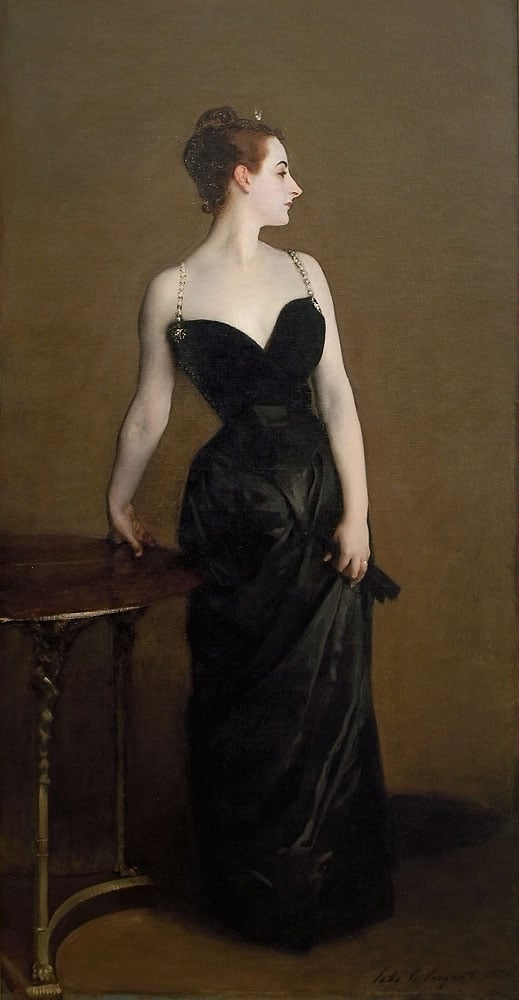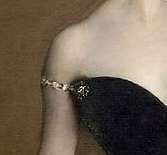Painting of a Woman in a Black Dress

Madame X, John Singer Sargent, 1883-4, oil on canvas
- KERA radio story:
- Expanded online story:
There were plenty of painted nudes among the thousands of artworks on display in the 1884 Paris Salon.
The Salon, of course, was the most important event in the art world at the time — partly because Paris was the most important city in the art world. The Salons were huge annual affairs with paintings hung up and down the walls in the Academie des Beaux-Arts — having been judged fitting by a committee of artists, critics and instructors. It was the publicity-distribution-gallery system of the time, all concentrated in a few days for hundreds of thousands of visitors. For painters, critical or public acclaim could mean lucrative commissions and social advancement. Simply being ignored could spell financial ruin.
Over the years, female nudes by Edouard Manet and Gustave Courbet had shocked Parisians with the artists' push toward an unsentimental realism. But in 1884, it was John Singer Sargent's painting known as "Madame X" that ignited public wrath. Yet it was only a portrait of a red-headed, pale-skinned woman in a simple, black, form-fitting evening gown standing next to an empty table. The painting is almost stark in its muted colors and its elegant lack of adornment, the better to highlight the woman's pearly skin, her red hair and her black dress.
Deborah Davis is the author of Strapless: John Singer Sargent and the Fall of Madame X . She will be speaking Saturday at the Amon Carter Museum in Fort Worth. She says that it was partly the woman and partly the dress that caused all the furor.
Amelie Gautreau wasn't posing as a mythical nymph or classic historical figure. Nor was she an ordinary artist's model. She was what today we might call a media darling, the trend-setting wife of a wealthy Frenchman, a young woman determined to hold the high-society spotlight.
DAVIS: "She was a combination of Princess Diana and Paris Hilton. She was at the very center of the culture. Everyone wanted to paint her, everyone wanted to see her, probably because she was such an unusual beauty."
The Paris tabloids even speculated that one of Gautreau's fashion secrets was taking tiny amounts of arsenic daily to keep her skin so incredibly white. But some in the press also resented that both Gautreau and Sargent were ambitious careerists and foreigners — young Americans who'd set out to conquer Parisian society and culture.
In reality, both could be considered more European than American: Sargent was born in Florence, was schooled as a French artist and didn't see America until he was in his 20s. Gautreau was a French Creole born in Louisiana, but her mother had moved her to France when she was eight. Despite such continental backgrounds, when the press turned on them (this was the first time Sargent had received negative reviews after several successful Salon appearances), their nationality became a target, partly because relations between America and France were strained at the time.
But ultimately, the uproar was triggered by a dangling shoulder strap (detail, above). Gautreau's gown was form-fitting and revealing enough — in a period in which women were typically cocooned in crinoline and skirts. But by accident, during Amelie's sitting, the right strap had slid off her shoulder. Sargent was normally a fast worker and had even dashed off an earlier, more casual image of Gautreau giving a toast at a dinner party. But he'd struggled with this one, and he found the loose strap an inspiration. It added a touch of warmth and life to what could have been a rather aloof and formal portrait. Part of the aloofness can be attributed to Gautreau's nose, which was actually an inherited family trait.
In retaining the off-the-shoulder strap, however, Sargent lent Gautreau the air of a married woman greeting a lover, her dress almost sliding off her breast. Illicit affairs were a common enough occurrence — this was Paris during the high hypocrisy of the Belle Epoque — but it was an inference not considered acceptable in public. (We know the woman is married because unconventionally for the time, Amelie wears very little jewelry, the better to show off her pearl-white skin. But her wedding band is quite distinct.)
DAVIS: "This woman standing with her strap hanging down – really, a kind of sexual invitation in the eyes of the audience – was more than they could take."
You don't see the dangling strap in the full painting above — the portrait as it exists in the Metropolitan Museum of Art in New York today — because after the scandal, after the Gautreau family had refused to pay for the portrait and it was returned to Sargent's studio, the artist repainted the strap in its 'proper' position. It wasn't until much later that historians discovered the change. The original position was "lost" because Sargent kept the painting for years out of the public eye, and only visitors to his studio could see it. As a result, the painting developed a 'cult' reputation, and Sargent began lending it out for exhibitions, eventually bequeathing it to the Metropolitan with a letter almost wistfully declaring he thought it was the best thing he'd ever done.

Later, after Sargent's popular successes and social esteem were initially belittled by modernist artists and critics, Madame X would be assessed as one of his masterpieces for its almost abstract look and its tension between restraint and eroticism. Today, it even recalls an ad by a master of American fashion like Calvin Klein — with its clean lines and elegant simplicity. But it's the scandal's angry mix of fashion, sex, art, prurience and celebrity that also sounds unmistakably modern, a precursor to the hysteria that has, at different moments, greeted Marilyn Monroe, Madonna, Janet Jackson — and on and on.
DAVIS: "In Paris, the people were obsessed with consumerism. They loved to shop. And they were among the first audiences for reality entertainment and tabloid journalism. We are them, they were us."
Source: https://artandseek.org/2009/03/25/john-singer-sargent-and-the-lady-in-black/

0 Response to "Painting of a Woman in a Black Dress"
Postar um comentário